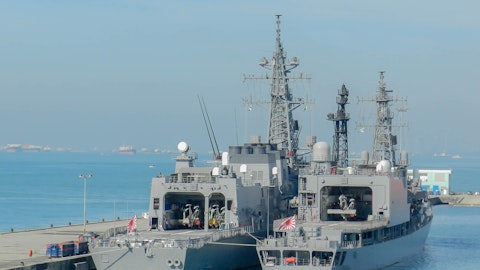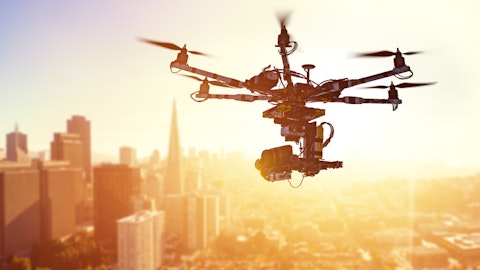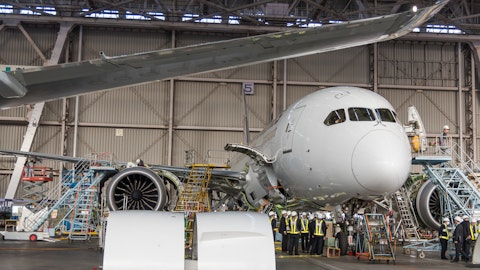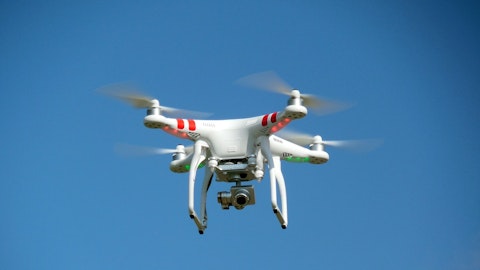AeroVironment, Inc. (NASDAQ:AVAV) Q3 2023 Earnings Call Transcript March 6, 2023
Operator: Good day, and thank you for standing by. Welcome to the AeroVironment Fiscal Year 2023 Third Quarter Conference Call. At this time, all participants are in a listen-only mode. After the speakers’ presentation, there will be a question-and-answer session. Please be advised that today’s conference is being recorded. I would now like to turn the conference over to your speaker for today, Jonah Teeter-Balin. Please go ahead.
Jonah Teeter-Balin: Thanks and good afternoon, ladies and gentlemen. Welcome to AeroVironment’s fiscal year 2023 third quarter earnings call. This is Jonah Teeter-Balin, Senior Director of Corporate Development and Investor Relations for AeroVironment. Before we begin, please note that certain information presented on this call contains forward-looking statements within the meaning of the Private Securities Litigation Reform Act of 1995. Forward-looking statements include, without limitation, any statement that may predict, forecast, indicate or imply future results, performance or achievements and may contain words such as believe, anticipate, expect, estimate, intend, project, plan or words or phrases with similar meaning.
Forward-looking statements are based on current expectations, forecasts and assumptions, which involve risks and uncertainties, including, but not limited to, economic, competitive, governmental and technological factors outside of our control that may cause our business strategy or actual results to differ materially from the forward-looking statements. For further information on these risks, we encourage you to review the risk factors discussed in AeroVironment’s periodic reports on Form 10-K and other filings with the SEC, along with the associated earnings release and safe harbor statement contained therein. This afternoon, we also filed a slide presentations with our earnings release and posted the presentations to the Investors section of our website at avinc.com in the Events and Presentations section.
The content of this conference call contains time-sensitive information that is accurate only as of today, March 6, 2023. The company undertakes no obligation to make any revision to any forward-looking statements contained in our remarks today or to update them to reflect this events or circumstances occurring after this conference call. Joining me today from AeroVironment are Chairman, President and Chief Executive Officer, Mr. Wahid Nawabi; and Senior Vice President and Chief Financial Officer, Mr. Kevin McDonnell. We will now begin with remarks from Wahid Nawabi. Wahid?
Wahid Nawabi: Thank you, Jonah. Welcome to our fiscal year 2023 third quarter earnings conference call. I will start by summarizing our performance and recent achievements, after which Kevin will review our financial results in greater detail. I will then provide a summary of our updated expectations for the remainder of fiscal year 2023 before Kevin, Jonah and I take your questions. Before I jump into the quarter, let me be clear about one thing. The fundamentals and underlying demand drivers of our business remain very strong and robust across all our product lines. Our businesses core operating metrics are clearly trending in a positive direction, including record backlog, significantly better gross margins and over 50% improvement on our adjusted EBITDA.
Our industry trends should continue to drive long-term sustainable and profitable growth for our business. In short, I believe the prospects for AeroVironment have never been better. Now, I will highlight a few key messages on the quarter, which are included on slide number three of our earnings presentation. First, third quarter results were in line with or slightly ahead of our expectations as we continue to successfully execute against our plan with solid enduring demand across our portfolio, as evidenced by our record funded backlog at the end of Q3 of more than $400 million. Second, given our strong backlog, we are narrowing our revenue guidance range and increasing our adjusted EBITDA guidance with the midpoint of our adjusted EBITDA range, representing more than a 50% improvement over last year.
And finally, we expect fiscal year 2024 to be another year of double-digit top line profitable growth for AeroVironment supported by our solid backlog and robust global demand for our innovative and best-in-class portfolio of intelligent unmanned robotic solutions. Now, let me summarize our financial results for the quarter. We delivered third quarter revenue of $134.4 million compared to $90.1 million in fiscal year 2022, representing an increase of nearly 50% year-over-year. The improvement was primarily due to a higher SUAS sales, which nearly tripled compared to the prior year period. This increase reflects strong Puma 3 AE and Puma LE shipments tied to our record Foreign Military Sales, or FMS, contract that we announced last quarter. Gross margin for the quarter was $45.5 million more than double last year’s $21.4 million, and our gross margin percentage rose to 34% from 24% last year.
The improved gross margin was primarily a result of higher volumes and favorable product mix. As we have previously discussed, we expect gross margins to further improve in Q4 excluding asset acceleration and remain elevated in fiscal year 2024 as our revenue mix shifts to more favorable product sales. We reported adjusted EBITDA of $23.7 million compared to $5.4 million in the third quarter last year. We ended the third quarter with a record backlog of $414 million and 83% increase year-over-year, reflecting the increasing robust demand for our solutions. Finally, non-GAAP EPS was $0.33 per diluted share as compared to $0.31 per diluted share for the third quarter of fiscal year 2022. This increase was primarily driven by a higher revenues and favorable product mix more than offsetting increased operating expenses, interest expenses, and lower tax benefits.
For comparison purposes, fiscal year 2022 third quarter included a $15 million tax benefit. Looking ahead, recent contract awards and increasing demand for our portfolio of intelligent multi-domain robotic solutions gives us confidence that we’re positioned for strong performance and value creation beyond this fiscal year. The conflict in Ukraine over the last year has showcased the unique value of our innovative solutions and the critical role they play in giving Ukraine, the U.S. and its allies, an advantage on the battlefield, especially against near-peer adversaries. As our solutions continue to play an essential role in Ukraine’s defense, we expect to capitalize on opportunities directly related to this conflict, while simultaneously helping the U.S. and its allies prepare for the future.
Despite shifting U.S. DoD funding away from medium UAS COCO operations, AeroVironment remains well positioned for us DoD ‘s key budget priorities. Demand for our products and services has resulted in a new record backlog. Further proposal activity remains elevated and we continue to hold productive discussions with domestic and international customers. And finally, we remain diligent in managing the ongoing global supply chain constraints and inflationary pressures in a tight labor market. Our prudent actions have allowed us to meet the needs of our customers while continuing to invest across our portfolio for growth and scale. I would now like to switch gears and provide an update on current developments within each of our product lines. Let me begin with our small UAS or SUAS product line where revenue rose newly 200% compared to the prior year period.
This primarily reflects our recent record FMS award for Puma LE and Puma 3 AE systems. We announced last quarter that this FMS contract had a maximum ceiling value of $176 million, and we now have current funding of $132 million. During Q3, we expedited production and shipped a solid portion of the initial funded amount. Additional funding up to the full value of this contract is expected, and we anticipate deliveries to remain at the current pace in the fourth quarter with remaining shipments occurring in fiscal year 2024. This year has been pivotal for SUAS product line with strong growth, new product introductions and system upgrades that will set the foundation for growth for years to come. The transformation of this product line has been the result of consistent prudent investment, which has resulted in improved technology that kept us ahead of the competition, especially as the U.S. DoD and our allies turned their focus to near-peer threats and contested environment operations.
I also want to note that our team recently visited Ukraine again, where we have people continually on the ground to ensure the success of our products. We’ve received excellent feedback that our Puma systems are scouting targets for every weapon system that the U.S. Department of Defense has provided to Ukraine. This speaks volumes to the capability and reliability of our solutions. Suffice to say that our Puma systems are one of the most effective assets that the U.S. has provided to Ukraine throughout this conflict. Switchblade loitering munitions in other U.S. DoD supplied weapon systems are even more potent when combined with Puma for ISR, targeting and battle damage assessments. Our products are proven to be essential to the country’s defense efforts, and we are honored to continue to our support for the people of Ukraine.
We are proud of how important our SUAS products have become for the U.S. DoD and its allies across the globe who rely on them for their safety and security while we continue to invest in the future of this product line. Moving to our Tactical Missile Systems, or TMS, product line, we continue to experience strong demand. Total TMS revenue is up roughly 30% year-over-year, which reflects the continued orders of our Switchblade 300 and 600 systems to support Ukraine, including the latest $2 billion security assistance package announced on February 24th, and Backwell depleted U.S. DoD stockpiles. On our team’s recent trip to Ukraine, we reaffirmed that our Switchblade 300 and 600 are performing well in combat operations and Ukrainian military officials are requesting many more of them.
Order activity remains elevated, given the high degree of visibility these systems have received over the past year. This past December, the Lithuanian Minister of Defense announced the country’s intent to purchase our switchblade loitering munitions for their forces. Disagreement with the U.S. DoD for the delivery of Switchblade 600s would make Lithuania the second country outside of the United States to procure this battle proven capability. We have yet to receive this contract from the U.S. DoD, and it is not reflected in our backlog, but it is expected to be worth approximately $45 million. Given the current level of interest and demand in switchblade, we expect significant growth in our TMS business going forward. As with our Puma SUAS products, AeroVironment remains a leader in loitering munitions with unmatched reliability and performance, setting us apart from the competition while driving strong demand.
I will now discuss our medium UAS or MUAS product line. We continue to work on the increment one of the U.S. Army’s future tactical UAS or FTUAS program, training personnel in Germany while undergoing flight testing at the U.S. Army’s Redstone Arsenal in Huntsville, Alabama. We’re also excited to share that the U.S. Army recently selected AeroVironment for Increment 2. During this phase, we will compete with several other vendors, which will allow the Army to select the best system for its needs. We are the only company to have secured sole source awards for Increment 0 and 1 of this contract. Additionally, we also remain the only company who has been selected and awarded contracts for all three phases of the FTUAS program. As we enter this phase of the competition, we’re confident that our JUMP 20 system is the most mature and capable solution in its class, and will continue to work closely with the U.S. Army to ensure we meet or exceed their performance needs, both today and in the future.
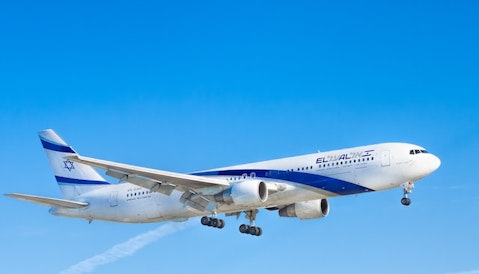
Photo by John McArthur on Unsplash
As part of our selection for Increment 2, we received an initial award from the U.S. Army, and there are additional opportunities for funding throughout Increment 2. Since Ukraine has been the near term priority for U.S. defense spending, programs outside of this priority, including those that typically utilize the JUMP 20 aircraft, are simply not seeing as much activity. With that said, JUMP 20s have been included in the latest security assistance package for Ukraine, and we believe long-term outlook for MUAS remains top bright. International interest in the JUMP 20 platform continues to grow, and there are other large U.S. DoD programs on the horizon with a potential $1 billion program record and multiple international and domestic opportunities, we are optimistic about MUAS growth potential in the years ahead.
Moving to our unmanned ground vehicles or UGV product line, our team has been making progress on our previously announced contract to provide telemax and tEODor ground vehicles to Ukraine. We have already delivered a telemax EVO robots under an accelerated schedule. Our record telemax models are known for their advanced, specialized precision manipulation, autonomous functionality, and intuitive operation. In addition, while UGV sales were down slightly year-over-year, we received a record number of orders this quarter, totaling more than $25 million. We’ve also recently released several new accessories including a CBRN Kit, 360 degree camera and a mini Bluetooth controller. Proposal activity remains solid and we anticipate sequential growth in this product line as well.
Within our HAPS product line, we continue to execute on our current contract with SoftBank for the next-generation Sunglider, with the goal of developing and commercializing stratospheric based telecommunication services. At the same time, we remain fully engaged with the U.S. DoD across multiple fronts that could lead to contracts in the coming quarters. There is a growing need for high altitude, ultra long endurance persistent ISR capabilities for defense and security applications, potentially even against foreign-based unidentified flying objects. Sunglider provides unique benefits compared to satellites and ground-based infrastructure. We now expect HAPS revenue between $35 million to $40 million this fiscal year. And finally, I’ll share some exciting developments at MacCready Works Advanced Solutions.
In February, our Ingenuity Mars Helicopter reached a milestone of 47 flights on its extended support of the Perseverance Rover, helping NASA search for evidence of ancient life and the Jezero Crater. Ingenuity’s original manifest called for only five flights, but the mission has continued due to the helicopter’s remarkable reliability and endurance as evidenced by the helicopter’s recent awakening from the Martian winter. Ingenuity has become an important partner in scouting ahead of for perseverance, so much so that NASA and the European Space Agency have altered their future Mars sample return plans to include two new helicopters. AeroVironment has recently received an initial award for the development of this next-generation helicopter, and we are optimistic about future larger contracts as this program moves forward.
MacCready Works is experiment — experiencing steady demand across federal and defense agencies programs which value artificial intelligence, machine learning, and contested environment logistics as we continue to integrate many artificial intelligence and machine learning powered capabilities into our product portfolio. We anticipate that the MacCready Works product line will see increasing internal and external demand as we move into fiscal year 2024. In summary, we’re seeing positive traction across all our product lines and the future looks bright. In particular, the past few quarters have clearly set us apart and elevated our company to a new level. During the year, we’ve positioned Switchblade as a best-in-class solution for loitering munitions in near-peer conflicts, one the largest ever Puma FMS order providing unmatched surveillance and reconnaissance in Ukraine, and we were selected for U.S. Army’s FTUAS Increment 0, 1 and 2.
AeroVironment’s broad portfolio of unmanned solutions is utilized every day across the globe to help defend the lives of millions and move humanity forward through innovative breakthroughs and advanced engineered solutions. As an example, all four of our largest product lines, SUAS, MUAS, TMS, and UGV are playing a critical role by giving Ukrainian forces an advantage against their much bigger adversaries. This is a testament to how relevant and meaningful our innovative solutions are in today’s conflicts. We believe we’re well-positioned to benefit from this macro trend as all militaries adopt more unmanned systems as part of their force structures, whether it be on Earth or Mars, we are building products that nations, leaders and scientists rely on to make better decisions going forward.
With that, I would like to now turn the call over to Kevin McDonnell for a review of second quarter financials. Kevin?
Kevin McDonnell: Thank you, Wahid. Today I’ll be reviewing the highlights of our third quarter performance during which I will occasionally refer to both our press release and earnings presentation available on our website. Revenue for the third quarter of fiscal 2023 was $134.4 million, an increase of 49% compared to the third quarter of fiscal 2022 revenue of $90.1 million. Slide five of the earnings presentation provides a breakdown of revenue by segment for the quarter. Our latest — our largest segment during the quarter was our small UAS business, which finished a quarter with $69.4 million of revenue up from last year’s $24.4 million. As Wahid mentioned the increase in revenue in the quarter was primarily a result of the large FMS Ukraine order received at the end of the second quarter.
Tactical Missile Systems or TMS contributed $24 million of revenue compared to $18.6 million last year during Q3. This increase was driven by a higher level of TMS manufacturing activity in the quarter, which was recognized based upon revenue over time accounting. The medium UAS segment finished the quarter with revenue of $15.4 million, a 27% decrease compared to the third quarter of fiscal 2022. The reduction of revenue was a result of lower COCO service revenue, which in turn was caused by a decrease in the number of MEUAS sites operated. Our HAPS segment contributed $8.9 million in Q3, a decrease from $9.5 million in the prior year third quarter. Revenue from the other segment increased year-over-year to $16.7 million versus $16.4 million in last year’s third quarter.
Turning to gross margins. Slide five of the earnings presentation shows the mix of product versus service revenue. During the third quarter, product revenues represented 68% of total revenues versus 47% in the same quarter last year. This is in line with our expectation that product mix shifts back to closer to 70% for the second half of fiscal 2023 as a result of significantly higher sales of SUAS products and a slight decrease in MUAS service revenue. Slide six of the earnings presentation shows the trend of adjusted product and service gross margins, while slide 12 reconciles the GAAP gross margins to adjusted gross margins, which excludes intangible amortization expense and other non-cash purchase accounting items. For the third quarter GAAP gross margins increase to 34% from 24% year-over-year, and adjusted gross margins increased to 36% from 29%.
The rise in both GAAP and adjusted gross margins can be attributed to a boost in overall revenue and the higher product mix from the increase in product revenue in both small UAS and TMS segments. However, this decrease was partially offset by a $4.3 million accelerated depreciation of medium UAS COCO assets, which had a negative impact on service gross margins. We expect another $6 million of accelerated depreciation of COCO assets in Q4 related to MUAS site reductions. Even with the accelerated depreciation of medium UAS COCO assets in the last two quarters and in the fourth quarter, our overall adjusted gross margins for the year will be in line with our FY 2022 overall adjusted gross margins as the favorable product mixes offset the negative impact from the accelerated depreciation.
Adjusted product gross margins for the quarter were 41% versus 38% in the third quarter of — versus 38% in the third quarter of last fiscal year, primarily due to the higher SUAS product mix. In terms of adjusted service gross margins, the third quarter was 26% versus 22% during the same quarter last year, primarily due to improved service mix. In terms of adjusted EBITDA, slide 13 of our earnings presentation shows the reconciliation of the GAAP net loss to adjusted EBITDA. In the third quarter of fiscal 2023, adjusted EBITDA was $23 million, representing a significant increase of $17 million from last year. The main factor contributing this increase was higher adjusted gross margins, and this was partially offset by higher adjusted SG&A expenses and investments in R&D.
We expect adjusted EBITDA for the year to be very strong at $89 million to $95 million, and as Wahid mentioned, this represents an over 50% year-over-year increase to the midpoint of this range. Now turning to GAAP earnings. In the third quarter, the company experienced a GAAP net loss of $0.7 million versus a net income of just above breakeven recorded in the same period of last year. We had a significant increase in GAAP gross margins of $24.1 million versus last year. However, this was more than offset by a variety of factors, namely a $14.9 million decrease in the tax benefit and increase a $3.2 million of unrealized losses on our equity and equity method investments, a $3.1 million increase in R&D spending and a $2.2 million rise in SG&A expenses and a $1.3 million increase in interest expense.
Slide 10 shows the reconciliation of GAAP and adjusted or non-GAAP diluted EPS. The company posted adjusted earnings per diluted share of $0.33 to the third quarter of fiscal 2023 versus $0.31 per diluted share for the third quarter of fiscal 2022. I should note that our adjusted EPS calculation now excludes equity method gains and losses from the adjusted EPS calculation. This activity is clearly called out on the income statement and is non-operating. Turning to our balance sheet. Total cash, restricted cash and investments at the end of the quarter were $104.5 million, which is a decrease of $19.3 million from the second quarter of fiscal 2023. As indicated in prior quarters, we expect to see continued increases in inventory and other working capital to support our record backlog and expected bookings as we manage through supply chain shortages by buying inventory and critical components when available.
We continue to have a strong balance sheet with over $100 million of cash, restricted cash and investments and approximately $100 million available under our working capital facility. I’d like to conclude with some highlights of our backlog metrics. Slide eight of the earnings presentation provides a summary of our current fiscal 2023 visibility. As Wahid mentioned our funded backlog at the end of the third quarter of fiscal 2023 was a record $414 million. Our visibility as of today to the midpoint of our revised guidance range is over a 100%. In other words, we are fully covered by the existing backlog to achieve our full year revenue guidance. We also expect orders to continue to be strong for the remainder of fiscal 2023. Now I’d like to turn things back to Wahid.
Wahid Nawabi: Thanks Kevin. As we approach the end of fiscal year 2023, we have enhanced visibility into our financial performance this year and next. With a record funded backlog and increasing demand across the board, and given the recent MUAS site closure, we have adjusted our current year guidance. Our updated outlook for fiscal year 2023 is shown on slide number seven and is as follows. We anticipate revenue of between $510 million and $525 million. We’re now expecting net income between $0.3 million to $5 million, or gain of $0.01 to $0.21 per diluted share. Non-GAAP adjusted EBITDA of between $89 million and $95 million, and non-GAAP earnings per diluted share, excluding acquisition related costs, amortization of intangible assets, and other one-time expenses, of between $1.13 and $1.33.
While we are raising revenue and adjusted EBITDA guidance, we have reduced our GAAP and non-GAAP EPS outlook as a result of the closure of our remaining MUAS COCO site. I want to emphasize that the primary impact from the closure is from the acceleration of the depreciation on certain of our MUAS assets and is a non-cash impact. As I mentioned earlier, this resulted from shifting U.S. DoD priorities and we expect these events to occur in the fourth quarter with no impact in fiscal year 2024 on our consolidated results. In addition, we have reduced net income guidance due to greater than expected unrealized losses tied to equity investments. This occurred as a result of mark-to-market accounting related to our investments in strategic partnerships and venture activities.
However, we believe adjusted gross margins will strengthen going forward, driven by favorable product mix and higher volumes. We expect to deliver adjusted EBITDA of between 16% and 18% of revenue for the full fiscal year. R&D investments for this fiscal year is expected to remain between 11% to 12% of revenue. As I mentioned before, the fundamental demand drivers of our business remain strong and robust across the globe. As the opportunities in front of us have grown, we have continued to prudently invest in our people, products, processes, and inventories. These investments plus our elevated visibility bolstered by innovation, decades of battle proven experience and incredible durability in harsh environments positions us well for the challenges of tomorrow.
We have rapidly grown the company while maintaining a focus on efficiency and execution, laying the foundation for even higher performance going forward. Before turning the call over for questions, let me once again summarize the key points from today’s call. First, we deliver third quarter performance in line with or greater than our expectations, as evidenced by a record backlog of $414 million. Second, with our record backlog and key wins over the past few quarters, we have a high degree of confidence in our prospects for value creation in fiscal year 2023 and beyond. While labor and supply chain challenges persist as we scale the business, we are overcoming these headwinds to meet the needs of our customers and are confident in our ability to deliver against our objectives and achieve another record year for the company.
And third, we look — as we look ahead, our portfolio is well positioned to take advantage of macro trends. Our solutions have proven vital and ensuring the safety of the U.S. and its allies, and we stand ready to continue to support them now and in the future. I would like to again thank our staff for their contributions this quarter. They have been instrumental in achieving these great results. We value our employees, customers, and shareholders who put their trust in us every day to make the best systems and solutions that protect and improve people’s lives. And with that, Kevin, Jonah and I will now take your questions.
See also 15 Countries with Highest Inflation Rates and 20 Most Important Companies in the World.
Q&A Session
Follow Aerovironment Inc (NASDAQ:AVAV)
Follow Aerovironment Inc (NASDAQ:AVAV)
Operator: Thank you. Our first question comes from the line of Peter Arment with R.B. Baird. Your line is open. Please go ahead.
Peter Arment: Yeah. Thanks. Good afternoon, Wahid, Kevin, Jonah. Wahid, can you give us an update on just the supply chain, how things are evolving there? I know there had been some discussions in the past that things were starting to get a little better with chips, but there are obviously a lot of other components and just related to how that’s affecting both when we think of small UAS and then TMS.
Wahid Nawabi: Sure, Peter. In general, the supply chain constraints have overall improved slightly. Although, it is still a challenge on a day-to-day basis. For a fourth quarter, we have pretty much our supply chain well addressed and taken care of. But beyond fourth quarter for next fiscal year, there’s still some areas where supply chain remains to be a constraint. The most important area for us remains the warhead for our Tactical Missile Systems, the Switchblade 300, 600, which we do not make that we receive those from General Dynamics and Northrop Grumman. Both of those two warhead are highly in demand and supply is still a challenge on a quarterly and annual basis. Besides the warhead for small UAS, medium UAS, UGV and other products, there are still some semiconductors supply chain constraints.
But overall, since last quarter has as improved to some extent, although it’s still an ongoing challenge. We expect that to continue throughout next fiscal year. Although, the improvements that we’ve seen in the last couple of quarters gives me some hope and optimism that things are going to get to get better and better.
Peter Arment: Yeah. And just as a follow up, is your — you mentioned the warhead. Is there alternative sources, because it seems like you’re being held back by the demand for Javelin and some of the other products that use similar type warheads? Could you discuss that a little bit if there — if that’s an opportunity for your long-term? Thanks.
Wahid Nawabi: Sure. Peter, great, great question. Certainly there is alternatives, but that takes a little bit of time. We have already started even before the conflict in Ukraine, alternative patch to be able to source other war hits for Switchblade 300 and 600. The challenge with 600 is, is that it shares the same warhead that the government furnishes for both the Javelin Missile as well as our Switchblade 600, the anti-tank Javelin Missile. And so, the production capacity on that takes a while for it to ramp up an increase. While that’s going on, we are already working on multiple, not just one, multiple other options on how to source other warheads that are equivalent and even warheads that have different mission capabilities for both Switchblade 300 and 600.
This is top of mind for us. We’ve been focused on that for a while. Although, the certification process and selection and qualification does take time, and it’s a longer term goal that we are making progress towards as we speak.
Peter Arment: Appreciate the color. Thanks.
Wahid Nawabi: Thank you, Peter.
